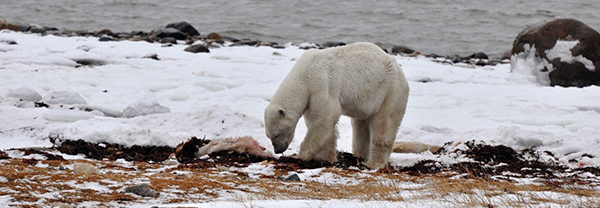
I have always dreamed about seeing polar bears in their natural habitat and experiencing the brisk breeze of the Canadian tundra, but once my foot stepped off the plane in Churchill, Manitoba, my heart raced as I prepared to live the dream and have my breath taken away. Indeed it was, as the cold Arctic air forced me to breathe shallow as the wind stole it from my lungs, and that was just the beginning.
On our first day out on the tundra, we witnessed a mama polar bear with her two yearlings. The cubs were playing in the kelp as mama was not too far away, keeping an eye out for any sign of danger in the distance. Once done with the kelp wrestling, the polar bear cubs crossed the frozen tundra and followed close to their mama as they settled down in the bush for a nap.

After our adventure on the tundra and on our way back to our hotel we noticed an old and emaciated male polar bear getting too close to town. He seemed worn out and tired. It made my heart heavy and I wished him good luck.
The next morning, the colorful dawn seem to last forever, and I felt as if I were still asleep as we made our way across the tundra to the Hudson Bay. The Polar Rover swayed back and forth over the rocky terrain, slowly making its way to the next exciting polar bear encounter. Soon, there was a buzz that made its way through the buggy—someone had spotted a bear.

We were all so excited beyond belief to see another one of these majestic creatures. And there he was, protecting his new kill, eating and enjoying every morsel. I thought I recognized him to be the bear from the previous night—the old, tired emaciated bear—and felt happy that he had a meal. We all watched in awe, not really questioning what he was eating, then over the radio we heard the news that he was eating a baby polar bear cub.
“Was it from the family we saw yesterday?” everyone wondered, then sadness washed through everyone on the Polar Rover as we understood the true impacts of climate change. There was not enough ice for the polar bear to get a proper meal, so he made due with what presented itself. Perhaps it was just me, but I felt that this old bear looked ashamed of what had become of him, but in order to survive he did what he had to.

After feeding for a while longer, the old polar bear looked sideways at the tundra buggy, then settled down next to his new kill for a nap.
I have always heard about climate change and commented about it on hot January days at home in Colorado, but I had never truly understood the profound impacts that it has on all living things until that moment. Other Nat Hab travelers have had similar experiences during their Churchill polar bear adventures, and each of us are now more motivated than ever to do what we can to help reduce the impacts of climate change and protect this iconic, threatened species.

This guest post was written by Natural Habitat Adventures Administrative Assistant Camie Kirkevold. All photos © Camie Kirkevold.

























